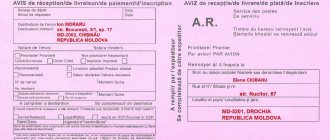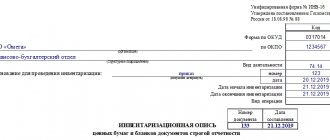Why do you need an inventory?
This simple paper allows you to immediately record all the documents provided by the employee upon employment. Subsequently, it records all newly received papers in the personal file, the facts of seizure of documents for any needs and their return.
The blame for the loss or damage of the papers contained in the inventory is shifted to the shoulders of the employee responsible for storing personal files, which is a good reason to approach the preparation of the inventory very carefully, taking into account the fact that in practice there have been precedents for going to court regarding documents lost by the company.
Requirements for orders for personnel
“Standard instructions for office work in federal executive bodies” (approved by order of Rosarkhiv No. 68 of November 27, 2000) contains requirements for registration and a list of necessary details that must be indicated in orders for personnel.
So, the form format should be A4, font: No. 13. The text should be aligned to the left, maintaining one and a half spacing on the left, the red line should be indented - 1.25 cm.
It must be indicated:
- Name of company.
- The word "Order".
- Date (written in both numbers and words) and number (No. and serial number).
- A clearly worded title without a period.
- The first (stating) part briefly outlines the reason, goals and objectives of issuing the order. This is followed by the second part of the text, beginning with the word “I order.”
- The second part (administrative) reveals the first. It contains instructions, performer and deadlines.
- Positions of endorsers, their signatures with transcripts, dates.
- Signature of the employee who has reviewed the document.
- A note on execution and forwarding it to the case.
For the most convenient work, all personnel regulations are distributed depending on the year of their adoption, observing chronology, and stored separately from other documents.
What personal files should an inventory be compiled for?
The law does not require an internal inventory of documents stored in the personal files of employees. However, there are some cases to which an inventory must be attached (as reflected in the relevant legislative regulations). These include
- those folders that are transferred to the enterprise archive for permanent or long-term storage (over 10 years),
- as well as those that have a simple heading “personal file” (that is, it is not clear from them exactly what documents and in what quantity they contain).
What is an internal inventory of documents (cases)
An internal inventory is usually understood as a list of documents combined into a certain category (in document science, most often called a case), through which the documents are properly indexed, classified and numbered.
Cases of permanent and temporary (over 10 years) storage periods, as well as personnel files, after the end of the calendar year in which they were opened, must be completed, described and prepared for transfer to the organization’s archive. Drawing up an internal inventory of documents is one of the elements of filing a case (clause 4.19 of the Rules for organizing the storage, acquisition, recording and use of documents of the Archival Fund of the Russian Federation and other archival documents in government bodies, local governments and organizations approved by order of the Ministry of Culture of Russia dated March 31 .2015 No. 526).
The internal inventory form is given in Appendix 27 to Order No. 526 of the Ministry of Culture of Russia dated March 31, 2015. You can download its form and sample by clicking on the picture below:
Is the organization obliged to maintain personal files of employees and what documents should be kept in the personal file? The answer to this question is in ConsultantPlus. If you do not have access to the K+ system, get a trial demo access for free.
Who should draw up the document
Maintaining personal files falls within the competence of personnel specialists, therefore compiling an inventory of the documents stored in them is also their prerogative. But in some cases (for example, in small businesses), the inventory can be drawn up by the secretary or head of the company - the main thing is that the employee has a sufficient level of qualifications to fill out the document in the correct order and in its entirety. This is especially true now that the previously approved procedure for conducting personal affairs has been canceled and employees of enterprises in this process must rely only on their experience and generally accepted practice.
How to draw up an internal inventory of personal documents
Today there is no single, unified, mandatory sample of this document. Therefore, companies can use one of two options:
- each time, as needed, compose it in any form (which is inconvenient when there are a large number of personal matters),
- use a template developed and approved by the organization (it must be registered in the company’s accounting policies).
The document must contain a number of information:
- Business name,
- position and full name of the employee whose documents are described,
- list of described documents,
- a complete list of papers stored in the personal file (as well as their copies).
The inventory includes not only work books, education documents and certificates of advanced training courses, but also award sheets, copies of orders and instructions concerning the employee, lists of scientific works, information about academic degrees, etc.
It is best to enter basic information into a document in the form of a table.
It should also be noted that as the personal file expands, all new papers entering it should also be recorded in the inventory, as well as those that are removed from it or, conversely, returned to it (indicating the persons and the reasons why they needed).
The procedure for making an inventory of an employee’s personal file
Human resources specialists are usually responsible for preparing inventories of personal files. At the same time, they adhere to some rules and practice-tested techniques:
- The list of papers contained in the case is located at the very beginning.
- The inventory can be drawn up manually or printed.
- For organizations operating in some areas (for example, government agencies), unified inventory forms are provided. Other companies may develop their own, based on the structure and specifics of their activities.
- The register is compiled primarily in the form of a table that describes the contents of the personal file. It must provide a sufficient number of columns for entering all documents.
- The papers in the file are placed and described in chronological order. This allows you to trace the entire work activity of an employee from admission to the company to dismissal.
- When new papers are received or removed from the file, appropriate notes are made in the inventory.
- The inventory is placed on several pages, numbered separately from the case documents.
See also: Open space in the office - what is it?
The tabular part of the internal inventory of an employee’s personal file, as a rule, contains the following information about the papers contained in it:
- Serial number.
- Registration number.
- Date of registration.
- Document's name.
- Numbers of those pages of the case on which it is located.
- Note. This column is used for various marks, for example, about retrieving a document from a personal file.
In addition to the table with a list of papers, the inventory contains certain details:
- Name. As a rule, the wording “personal file inventory” is used. The last name, first name and patronymic of the employee, as well as his position, are indicated. In large companies, a structural unit is mentioned.
- Information about the person who compiled the inventory. The personnel officer who draws up the register indicates his position, last name, first name and patronymic, and also affixes his signature.
- The total number of documents in the case (in numbers and words).
- Number of pages of inventory.
- Date of preparation. Indicated after completing the filling of the case.
How to fill out an inventory of personal documents
The document can be drawn up either by hand (using a ruler, pencil and pen) or printed on a computer (the most convenient, because you can print the required number of copies at once). It can be filled out on a blank A4 sheet or on the company’s letterhead (it doesn’t matter). Usually one copy of the document is made for each case, but if an employee asks for a copy, the employer’s representative has no right to refuse him.
The inventory may consist of one or several sheets (if there is a large number of documents). If it contains many pages, they should be numbered.
When filling out a document, you should avoid inaccuracies and errors, and even more so, entering into it deliberately unreliable or false information - if such facts are discovered, this can lead to disciplinary punishment of the responsible employee.
The document can be stored in different ways, for example, glued to the back of the title page of the personal file folder, or simply placed in a folder (if the inventory has many sheets).
Download the form and sample of filling out the internal inventory of a personal file
At the beginning of the article there are links to download both the inventory form and a sample of its completion.
For convenience and understanding of how to fill out the document, below is a sample internal inventory of a personal file.
Internal inventory of personal file No. 1
employee of Vikhr LLC, Roman Petrovich Avdeev
| Item no. | Document date | Document Number | Title of the document | Case sheet numbers | Note |
| 1 | 11.05.2015 | 1-TD | Employment contract | 1-5 | |
| 2 | 11.05.2015 | 1-P | The order of acceptance to work | 6-7 | The document was provided to the employee on March 17, 2016 based on an application for the purpose of making a copy. Nikiforov A.G. The document was returned to the personal file by the employee as the need passed, 03/17/2016 Nikiforov A.G. |
| 3 | 17.10.2015 | 2-O | Order on granting leave | 8 | |
| 4 | 17.02.2016 | 1-PC | Order for advanced training | 9 | |
| 5 | etc. |
Total 4 documents
Number of internal inventory sheets 1
The inventory was compiled by the deputy head of the HR department A.G. Nikiforov.
Nikiforov
11.05.2015
***
Thus, an inventory of personal file documents is compiled for the convenience of personnel document management. The form for the internal inventory of personal file documents and a sample for filling it out can be downloaded from the links provided at the beginning of the article.
Sample of compiling an inventory of documents of a personal file
The title indicates the name of the inventory and the details of the employee whose personal records are being described. It also contains the name of the employing company.
Next, a list of inventory documents is drawn up in a table:
- document number in order,
- then its index (or number according to the internal document flow of the enterprise),
- date of preparation and signing,
- title, i.e. the name of the document (this is where the original or a copy is written),
- sheet numbers,
- notes, which usually indicate the condition of the document, the dates and reasons for its withdrawal and return, etc. information.
Below the table, the number of documents in the personal file is indicated in words.
At the end, the inventory is certified by the personal signature of the person responsible for the maintenance and storage of the employee’s personal files (indicating his position and deciphering the autograph).
What documents are included in an employee’s personal file?
The answer to the question: what should be in the personal file of an employee of an organization according to the law is not found in the Labor Code of the Russian Federation, federal laws and regulations (available only for civil servants). Current Russian legislation does not oblige the employer to maintain such documentation for all employees. The mandatory procedure for the formation and composition of an employee’s personal file in 2021 is established only for civil servants (Federal Law No. 79-FZ dated July 27, 2004, Decree of the President of the Russian Federation No. 609 dated May 30, 2005). For all other employees, legal entities and individual entrepreneurs maintain similar documentation on their own initiative; the procedure, forms, and composition are approved in local regulations.
The Regulations, approved by Decree of the President of the Russian Federation No. 609, state what documents should be in an employee’s personal file in 2022 if he is a civil servant (clause 16):
- application for a job;
- questionnaire;
- copy of the passport;
- copies of civil status acts;
- copies of military registration documents;
- copy of TIN, etc.
An ordinary employer does not have the right to request personal data not related to work activity (according to Roskomnadzor, confirmed by judicial practice). To avoid breaking the law, the HR department has the right to store only those papers relating to a specific employee that were created directly in this company. Here's what you can keep in the personal file of an employee (not a civil servant):
- employment contract and additional agreements thereto;
- orders for employment, internal transfers;
- orders for incentives or penalties;
- agreement on individual financial responsibility (if the position provides for it);
- agreement on non-disclosure of information related to secrets;
- reports and explanatory notes;
- acts of violation of labor discipline;
- dismissal order.
The personnel officer files each additional paper in a folder, observing chronological order, and compiles an inventory.
In order to avoid claims from the labor inspectorate, the documents in the folder are supplemented with consent to the processing of personal data. An internal inventory indicating a complete list of contents is required.
ConsultantPlus experts examined how to manage personal files of employees without violating the law on personal data. Use these instructions for free.







